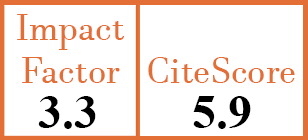Full Papers
Comprehensive magnetic resonance imaging evaluation in a cohort of 145 patients with Takayasu's arteritis. Proposal for a standardised and systematic reporting format
M.E. Soto1, G. Meléndez-Ramírez2, M.C. Herrera Zarza3, A. Meave4, M.Á. Cruz-Marmolejo5, A. Mendez-Dominguez6, J.S. Arias-Fernandez7, M.Á. Aguirre-Delfin8
- Research Direction, Instituto Nacional de Cardiología Ignacio Chávez and American British Cowdray Hospital Center, Mexico City, Mexico.
- Magnetic Resonance Department, Instituto Nacional de Cardiología Ignacio Chávez, Mexico City, Mexico. gabrielamelram@yahoo.com.mx
- Magnetic Resonance Department, Instituto Nacional de Cardiología Ignacio Chávez, Mexico City, Mexico.
- Magnetic Resonance Department, Instituto Nacional de Cardiología Ignacio Chávez, Mexico City, Mexico.
- Magnetic Resonance Department, Instituto Nacional de Cardiología Ignacio Chávez, Mexico City, Mexico.
- Neurology Outpatient Clinic, Mexico City, Mexico.
- Social Service of Investigation, Universidad Nacional Autónoma de México, Mexico City, Mexico.
- Social Service of Investigation, Universidad Nacional Autónoma de México, Mexico City, Mexico.
CER18591
Full Papers
Free to view
(click on article PDF icon to read the article)
PMID: 41105443 [PubMed]
Received: 02/02/2025
Accepted : 18/06/2025
In Press: 10/10/2025
Abstract
OBJECTIVES:
Takayasu’s arteritis (TAK) is a rare disease affecting the aorta and its branches. Magnetic resonance imaging (MRI) can assess vascular lesions, disease progression, activity, and the impact on different organs. Comprehensive MRI study including whole-body angiography (WBA) and target-organ assessment is not performed in all patients with suspected TAK. The aim of this study is to evaluate vascular and organic lesions in a cohort of patients with TAK who underwent MRI and to propose a standardised and systematic reporting format of the findings.
METHODS:
Patients with ≥4 TAK criteria who underwent MRI between 2003-2024, were included. With a standardised format, angiographic analysis of the presence and type of vascular lesion by segment was performed, including cerebral, cardiac, lower limbs, and visceral arteries, as well as the impact on the target organ.
RESULTS:
A total of 145 patients with mean age 36±15 years, 128 (88%) women were included. Type V of the angiographic classification was the most frequent. Involvement of cerebral 27 (18%), coronary 12 (8.2%), pulmonary 25 (17%), right renal 50 (34%) and left 42 (39%), lower limb arteries 48 (33%), stroke 27 (19%) was found. Cardiac MRI was done in 108 patients, any cardiac abnormality 70 (65%), myocardial infarction 10 (9.3 %), aortic regurgitation 26 (17%), mitral regurgitation 14 (8.3%) and complete AV-Block 1 (0.7%) was found.
CONCLUSIONS:
Comprehensive assessment of patients with TAK by MRI with a standardised and systematic reporting format is a tool that may allow better interdisciplinary communication in the study of this vasculitis.


